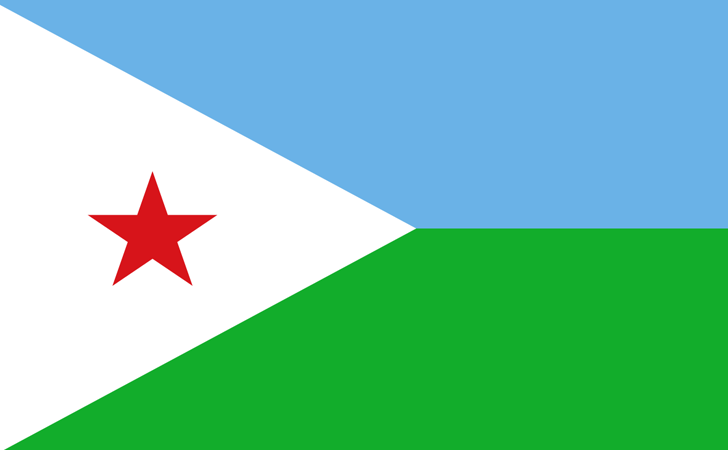
The national flag of Djibouti was accepted on 27 June 1977, succeeding the country's independence from France. Djibouti flag has the light blue characterizes the sky and the sea and Issa Somalis. The color green signifies the everlasting green of the earth, and afar people. The color white epitomizes the peace and the red star embodies the unity and the blood shed by the martyrs of independence.
The flag of Djibouti comprises of two equal straight bands of blue (upper) and green (lower), with a white isosceles triangle founded on the hoist side. Flag of Djibouti The triangle bears a red star in its center, which epitomizes unity and blood. Each color represents something dissimilar; such as the Earth as green, green, sea and sky as light blue, peace as white, and unity as red.
The French apprehended a small coastal area at the entry to the Red Sea during the “scramble for Africa” in the late 19th century. During the time, a local historical flag had basic red banner of the former sultanate of Tajoura. The designation for the coastal area, earlier it was altered to French Territory of the Afars and Issas. Changing political conditions in the 20th century caused in the independence of the area as a new republic, which took on the name of Djibouti today. As in many other lands, the flag of a party-political party finally was modified to become the new national flag. The current flag is grounded on a design that was used by the Liberation Front of the Coast of the Somalis. The flag was officially hoisted on June 27, 1977 after gained independence.
Djibouti is a multiethnic state, as reproduced in the design of the flag. The Issa are a subcategory of the Somali, while the Afar, or Danakil, are connected to people alive across the border in Ethiopia; both are Muslim. The Afar color is green, representative of prosperity. The Issa color is light blue, representing sea and sky and mentioning to the background color of the national flag of neighboring Somalia. In addition, the Djibouti flag has a triangle standing for fairness, its white color representing peace. It bears a star for unity, culture red for independence.
The Djibouti flag was formally adopted on June 27, 1977, after ahead its independence from France. Blue is depictys of the Issa people, the red star in the white triangle represents unity, and green the Afar people.
The nation is located in eastern Africa shares boundaries with Eritrea to the north, Somalia to the east, the Gulf of Aden, and Ethiopia to the west and south. The nation has 9.57 lacs inhabitants with population density of 37 people per square kilometer.
Djibouti is a semi-presidential regime country. The official language of Djibouti is French, Arabic and Somali. It uses Franc as their currency. Djibouti comprises of two letters Djibouti code i.e. DJ and its three letters Djibouti code is DJI and in digits it is 262. The calling code is +253 and the UTC i.e. standard time followed in Djibouti is UTC +03 hours. Being a semi-president republic has 5 regions and districts.
| Country | Djibouti |
|---|---|
| Continent | Africa |
| Official languages | French, Arabic |
| Capital | Djibouti City |
| Currency | Djiboutian franc Fr (DJF) |
| CET | UTC+03:00 |
|---|---|
| CEST | UTC+03:00 |
| Internet TLD | DJ |
|---|---|
| Three-letter country code | DJI |
| Three-digit country code | 262 |
| Calling code | +253 |